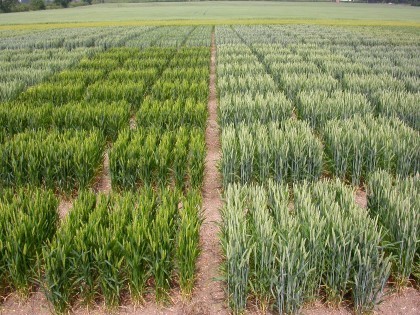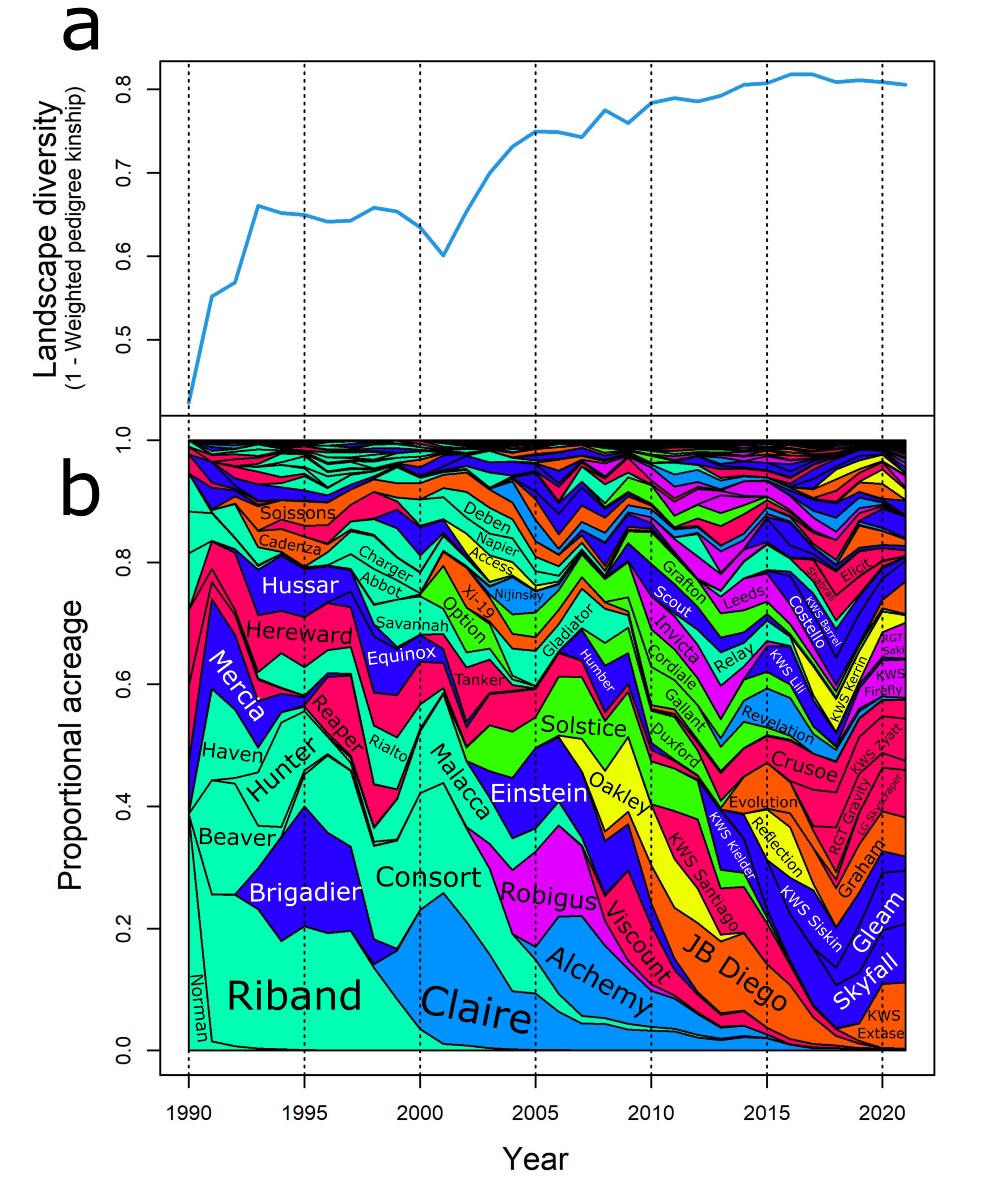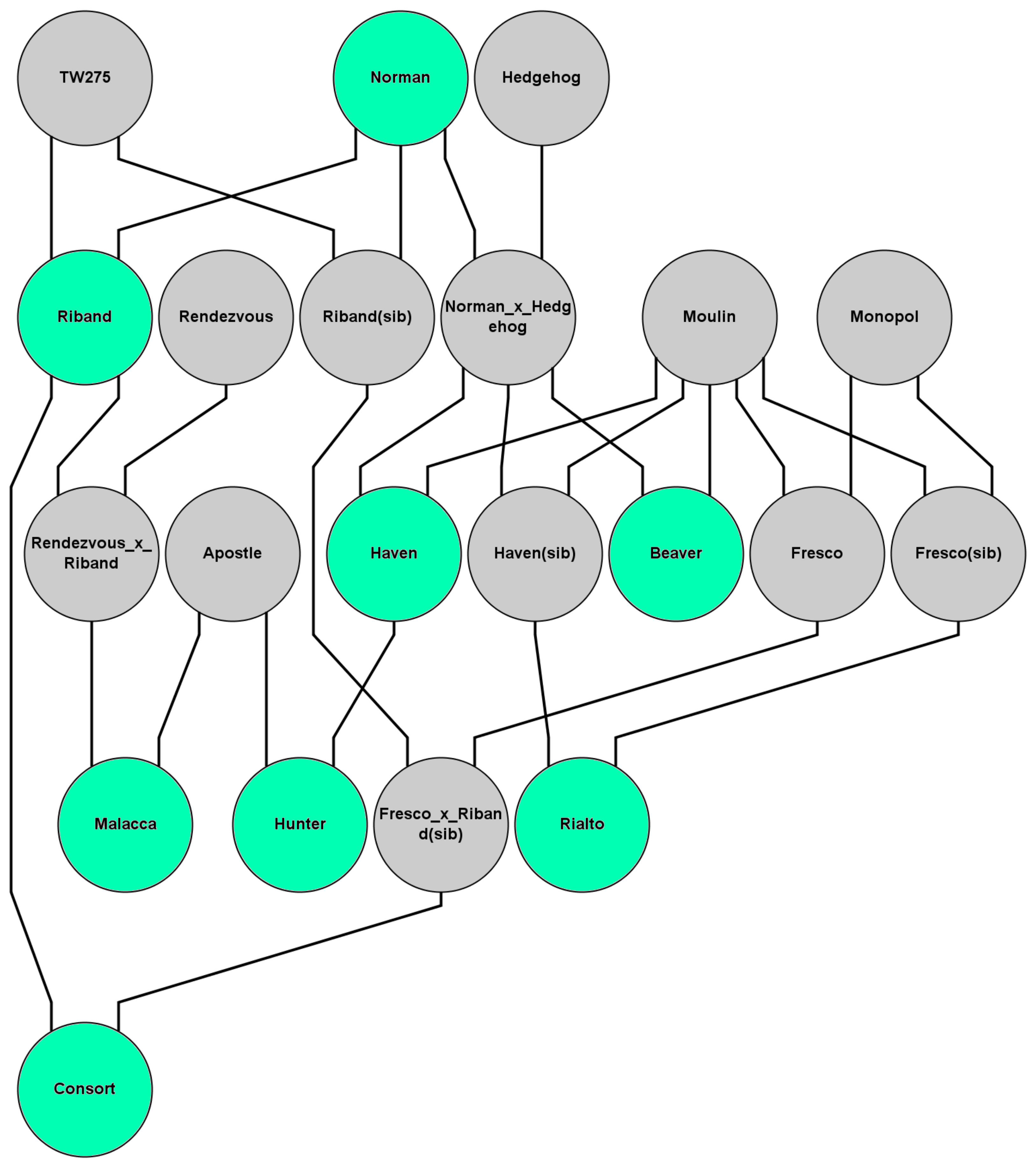
NIAB's Nick Fradgley looks at why ensuring a diverse and resilient wheat landscape is important and how NIAB is helping create just that.
There are concerns that modern arable farming systems have become too uniform and homogeneous and that this leaves our cropping systems vulnerable to unpredictable environmental shocks.
Although almost all wheat varieties in the UK are pure lines, ie all plants grown in a field are genetically almost identical, the diversity of wheat varieties grown across the whole landscape is more important when considering the productivity of a nation rather than just a single field.
In theory, each wheat variety (genotype) will be adapted to a particular range of environments and be sensitive to different biotic and abiotic stresses.
Having a greater diversity of wheat genotypes across the whole landscape should help hedge our bets to any environmental stresses future years may bring, and allow for selection of high yielding varieties adapted to the range of soil and climatic conditions available throughout the UK.
 As a clear example of how a variety has historically suffered from an unexpected environmental shock, the variety Moulin, bred by the Plant Breeding Institute (PBI), was released in 1985 but by the following year was found to have drastically low yields and ear sterility due to cold weather at flowering.
As a clear example of how a variety has historically suffered from an unexpected environmental shock, the variety Moulin, bred by the Plant Breeding Institute (PBI), was released in 1985 but by the following year was found to have drastically low yields and ear sterility due to cold weather at flowering.
Some yields were reduced by as much as 70% and growers even took legal action against seed merchants and PBI. Many varieties were subsequently bred from Moulin and concern remained that these associated issues would persist in the later varieties.
Plant breeding is often credited for achieving significant genetic gain in important traits like grain yield and disease resistance, but is also criticised for eroding genetic diversity by continually selecting and recombining material from within a finite genepool.
But how has the landscape of UK wheat varieties evolved since then and is it becoming too much of a monoculture that is sensitive to these environmental shocks? To investigate these trends, data on the areas of varieties grown across England each year, as well as the pedigrees of these varieties, were analysed.
A measure of relatedness based on shared parentage among varieties (kinship) can be calculated and this was then weighted by the proportional acreage of varieties grown each year to get an index of landscape diversity. This indicates, on average, how closely related wheat in two randomly selected fields would likely be.
Figure 1a. Trends in landscape diversity of wheat grown in England since 1990
and Figure 1b. Proportional area of wheat varieties based on data from NIAB SeedStats service.
Results showed that there has been an increasing trend in landscape diversity since 1990 as closely related varieties are less likely to be grown in the same year (Figure 1a). The most obvious trend is that there are now fewer varieties that take up such a large market share. Whereas varieties such as Riband and Claire each occupied almost 25% of the wheat area, now only a few milling wheat varieties, such as Skyfall and KWS Extase, achieve more than 10% market share.
 Although the dataset only goes back as far as 1990, historically there was even clearer dominance of a few highly successful varieties. At its peak in 1962 Cappelle Desprez was grown on 82% of the UK wheat area and was used as a parent for many PBI-bred varieties.
Although the dataset only goes back as far as 1990, historically there was even clearer dominance of a few highly successful varieties. At its peak in 1962 Cappelle Desprez was grown on 82% of the UK wheat area and was used as a parent for many PBI-bred varieties.
Similarly, the highly acclaimed variety Marquis was grown on over 80% of the Canadian wheat area in 1918. However, looking even further back to the early 20th Century when heterogeneously diverse cereal landraces were replaced by pure-line bred varieties, landscape diversity would likely have been even greater among a much larger number of localised landraces.
While fewer single varieties now have a large market share, many of the popular varieties before 2005 were also relatively closely related, shown by the same colour in Figures 1b and c. Norman, Riband, Beaver, Haven, Hunter, Consort, Rialto and Malacca all share a similar pedigree (Figure 2), and were grown over large areas at a similar period.
All these varieties, with the exception of Malacca, were bred at PBI, which closed in 1987 just before the start of this dataset. With increased competition among a greater number of private breeding companies, a greater diversity of wheat varieties have been bred and grown over the last few decades.
Figure 1c. Dendrogram of wheat varieties relatedness based on pedigree kinship.
The variety Robigus was released in 2000 and is thought to include some particularly novel genetics derived from a distant wheat wild relative. It represented a distinct increase in yield potential and was commonly used as a parent for subsequently released varieties, such as Leeds, Cougar and Invicta; a large proportion of current non-milling wheat varieties have Robigus somewhere in their pedigree. However, the introduction of Robigus does not seem to coincide with a drop in landscape diversity because the novel diversity introduced by Robigus has been effectively recombined with the existing elite wheat genepool.
Apart from the odd step change, such as the introduction of the reduced height dwarfing genes that clearly increase yield in optimum environments, the majority of genetic gain in yield has been due to steady accumulation of many small genetic effects. It is therefore remarkable that the breeders have achieved continued genetic gains in wheat yield potential without apparently depleting the genetic variance in the genepool.
 NIAB’s pre-breeding work has been operating a large re-synthesised wheat breeding programme which is mobilising a huge resource of genetic diversity from wheat wild progenitor species that are feeding into commercial wheat breeding programmes.
NIAB’s pre-breeding work has been operating a large re-synthesised wheat breeding programme which is mobilising a huge resource of genetic diversity from wheat wild progenitor species that are feeding into commercial wheat breeding programmes.
Similar to the introduction of Robigus, this input of new useful genetic variability is key to topping up the fuel tank of genetic variance that can be used to keep yield potential increasing and maintain the diversity of UK wheat at a landscape level.
Climate change will present increasingly unpredictable challenges to UK farmers. New races of wheat diseases are evolving to overcome varietal resistances at ever faster rates. However, the recent increases in wheat landscape diversity suggests that this is likely driven by changes in weather patterns that bring in new virulent races each year rather than lack of wheat diversity.
Nevertheless, ensuring a diverse and resilient wheat landscape will be even more important in the future and will rely upon continued innovations, such as from NIAB’s pre-breeding programme.
Figure 2. Pedigree showing close relationships among several popular varieties between 1990 and 2005.
